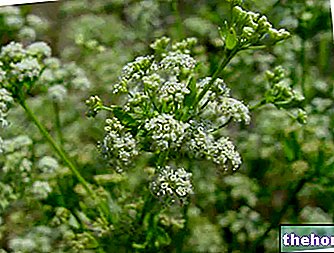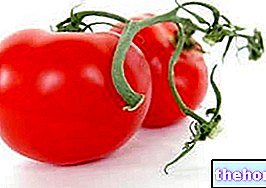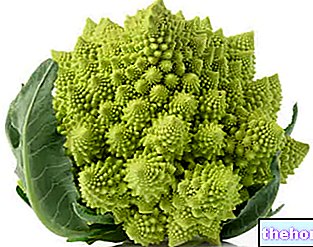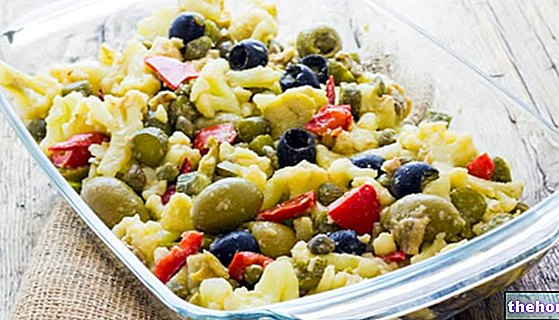Generality
Tubers are plant foods obtained from agriculture or the collection of spontaneous plants. They belong to the III group of foods and tend to owe their edibility to the cooking process (as happens for cereals and legumes).

The tubers are also used in animal nutrition, as they constitute the customary diet of some breeds such as the domestic pig and wild boar. Finally, the tubers of some plants play a leading role in modern phytotherapy; this is the case of Andean maca (tonic, immunostimulating), dioscorea (antioxidant and pain reliever), konjac (mild laxative and anorectic) and lovage (diuretic, urinary disinfectant and balsamic).
Description
Tubers are plant structures and constitute only a part of the whole plant; in particular, it is a portion of the stem that assumes a rather squat shape (globose and / or elongated) in which the vegetable crams its energy reserves. These are essentially made up of complex carbohydrates, or starch and / or inulin (not available to humans, but still important as a prebiotic dietary fiber).
The tubers tend to be located in the lower portion of the trunk, well hidden below the earth's surface, and only very few species develop them in the open. Tubers are NOT roots (like carrot) or tuberous roots (like sweet potato or American and cassava); They are NOT even bulbs (garlic, onion, chives, shallots, etc.) nor truffles.
Edible tubers
Not all tubers are edible. Potatoes are well known among the edible ones, but Jerusalem artichoke is also quite common. Others are not routinely used for food but this does not mean that they are not edible; some obsolete examples are: Oxalis tuberosa, Tropaeolum tuberosum, Dioscorea bulbifera And Cyperus esculentus.
- Potatoes: potatoes (binomial nomenclature: Solanum tuberosum) are the most common edible tubers in the world; we will not dwell on the specific description of the food and I suggest users to read the dedicated article: potatoes. Below we will simply mention the varieties available on the market and those recommended: potato Agate (yellow flesh, early production), potato Amber (large and well preserved), potato Imola (white paste, medium late and well preserved), potato Jaerla (globose, yellow flesh, smooth and light skin, medium - early production and resistant to drought), potato Kuroda (late, with red skin, rustic, resistant to diseases), potato Check (with regular and elongated shape, yellow flesh, smooth and yellow skin, early and abundant production), Kennebec (white paste, late and abundant production, resistant to late blight, resistant to drought, suitable for home winter storage).
- Jerusalem artichoke: Jerusalem artichokes (binomial nomenclature: Helianthus tuberosus) are less common edible tubers than potatoes (especially nationally). Jerusalem artichoke has a lower energy intake than potatoes because it provides higher rations of inulin (dietary fiber) and lower amounts of starch. Even in this case we will not dwell on its food description, for which I suggest reading the dedicated article: Jerusalem artichoke.
We remind you that there is also a wide range of NON-edible and even poisonous tubers; some examples are: Arum maculatum And Cyclamen hederifolium.
Cultivation
In Italy, the most favorable areas for the production of tubers (mainly potatoes) are the mountainous Alpine ones, since they allow these crops to develop a spring-summer cycle (from May to September). In the south, however, the tubers are planted in autumn to obtain an early production.
The tubers undergo freezing at -2 ° C and undergo absorption disturbances from the soil with temperatures above 30 ° C. As can be deduced, the soils suitable for the cultivation of tubers (especially potatoes) are siliceous or siliceous - clayey, slightly acidic, loose and permeable, deep and rich in organic molecules. The tubers can be cultivated using two generally complementary systems: the first is that of sowing, the second is that of vegetative multiplication (transplanting each portion of the sprouted tubers - clonal propagation).
ATTENTION! Edible tubers (and some berries such as tomatoes and eggplants) also contain some toxic molecules; this is the case with solanine. This glycoalkaloid it is normally present only in the leaves and stem of potato plants, but when the tuber is exposed to sunlight it begins to take on a more greenish color and sprout developing solanine. Therefore, wrinkled and shriveled potatoes contain higher quantities of toxin; to prevent this molecule from forming in the tuber it is necessary to store it in the dark, in cool places, and it is always advisable to cook the food carefully as the heat significantly reduces its concentrations.
Nutritional properties
Speaking of the nutritional properties of tubers, it should be remembered that, in Italy, potatoes represent the main representative of the category.
The tubers are portions of the plant aimed at conserving energy reserves; these stocks, consisting of starch and / or inulin, can also be very useful for human nutrition. The tubers therefore have a mainly energetic function (thanks to starch), but also prebiotic and intestinal preservation (by virtue of the presence of inulin ).
The tubers are not edible raw and always require a fairly consistent level of cooking, otherwise the digestibility and availability of energy nutrients would be negatively affected.
While the starch of the cooked tubers is well digestible and absorbable, the inulin constitutes a molecule not available to the human organism. This does not mean that it is useless, quite the opposite! The inulin contained in the tubers is a fructose polymer whose monosaccharides are bound by β-glycosidic bonds; for this reason it is not digestible by the digestive enzymes of the human being. On the other hand, this link can be separated from some microorganisms; at the level of the large intestine, in particular, inulin is dismantled by the physiological bifidobacteria which derive nourishment from it and develop in an excellent way; this function is called prebiotic. and synergistically with this reaction, inulin is also one of the most widespread viscous fibers; despite the "relative" solubility, it favors a gelation of the faeces that pass in a simple and uncomplicated way; for this reason the tuber inulin also plays a role in intestinal preservation.
In tubers, lipids are almost absent and proteins are scarce, as well as of low biological value.
Among the salts of the tubers, we remember the excellence of potassium and some microelements such as zinc and selenium; with regard to vitamins, potatoes have a good supply of niacin (vit. PP) and ascorbic acid (vit. C - almost totally annihilated by cooking).
No more details are available on the nutritional content of the less consumed tubers.
Other Foods - Vegetables Garlic Agretti Asparagus Basil Beets Borage Broccoli Capers Artichokes Carrots Catalonia Brussels sprouts Cauliflower Cabbage and Savoy cabbage Red cabbage Cucumber Chicory Turnip greens Onion Sauerkraut Watercress Edamame Chives Chanterelles Flour Cassava Flowers Pumpkin Flour Edible Flowers Pumpkin Seasonal Fruits and Vegetables Endive Salads and Salads Strengthening Salad Lettuce Aubergines Vegetables Nettle Pak-Choi Parsnip Potatoes American Potato Peppers Pinzimonio Tomatoes Leeks Parsley Radicchio Turnips Red Turnips Radishes Rocket Shallots Endive Celery Celeriac Seeds Sprouted Spinach Truffle Valianamberi or Jerusalem artichoke laxatives Saffron Pumpkin Zucchini Vegetables - Nutritional properties OTHER VEGETABLE ITEMS Categories Food Alcoholics Meat Cereals and derivatives Sweeteners Sweets Offal Fruit Dried fruit Milk and derivatives Legumes Oils and fats Fish and fishery products Cold cuts S pezie Vegetables Health recipes Appetizers Bread, Pizza and Brioche First courses Second courses Vegetables and Salads Sweets and Desserts Ice creams and sorbets Syrups, liqueurs and grappa Basic preparations ---- In the kitchen with leftovers Carnival recipes Christmas recipes Light diet recipes Women's Day, Mum, Dad Recipes Functional Recipes International Recipes Easter Recipes Recipes for Celiacs Recipes for Diabetics Recipes for Holidays Recipes for Valentine's Day Recipes for Vegetarians Protein Recipes Regional Recipes Vegan Recipes




























